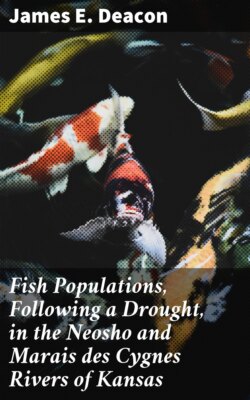Fish Populations, Following a Drought, in the Neosho and Marais des Cygnes Rivers of Kansas

Реклама. ООО «ЛитРес», ИНН: 7719571260.
Оглавление
James E. Deacon. Fish Populations, Following a Drought, in the Neosho and Marais des Cygnes Rivers of Kansas
Fish Populations, Following a Drought, in the Neosho and Marais des Cygnes Rivers of Kansas
Table of Contents
INTRODUCTION
Table 1. Stream-flow in Cubic Feet per Second, Neosho River near Council Grove, Kansas. Drainage Area: 250 Square Miles
Table 2. Stream-flow in Cubic Feet per Second, Neosho River near Parsons, Kansas. Drainage Area: 4905 Square Miles
Table 3. Stream-flow in Cubic Feet per Second, Marais des Cygnes River Near Ottawa, Kansas. Drainage Area: 1,250 Square Miles
Table 4. Stream-flow in Cubic Feet per Second, Marais des Cygnes River at Trading Post, Kansas. Drainage Area: 2,880 Square Miles
DESCRIPTION OF NEOSHO RIVER
DESCRIPTION OF MARAIS DES CYGNES RIVER
METHODS
Electrical Fishing Gear
Seines
Gill Nets
Sodium Cyanide
Rotenone
Dyes
Determination of Abundance
Names of Fishes
ANNOTATED LIST OF SPECIES
Table 5. Numbers and Sizes of Long-nosed Gar Captured by Shocker and Gill Nets at the Middle and Lower Neosho Stations in 1957, 1958 and 1959
Table 7. Length-frequency of Channel Catfish from the Neosho River, 1957, 1958 and 1959. (Numbers in Vertical Columns Indicate the Number of Individuals of a Certain Size Collected on That Date.)
Table 8. Length-frequency of Freshwater Drum from the Middle Neosho Station in 1957, 1958 and 1959
Table 9. Average Number of Individuals Captured per Hour, Using the Shocker, at Different Times of the Day and Night at the Middle Neosho Station in 1958. Numbers in Parentheses Indicate Total Number Captured
Table 10. Numbers of Fish Seen or Captured per Hour by Use of the Shocker. Excludes Fish Taken by Shocking into a Seine on Riffles; Young-of-the-year Channel Catfish and Flathead Catfish Predominated in Samples Taken by that Method
Table 11. Number of Occurrences (Roman type) and Number Counted (Italic type) per Seining Unit. One Seining Unit Equals 30 Seine-Hauls (ten each with the 4-foot, 12-foot and 25-foot seine) of Which Six Randomly-chosen Hauls Were Counted. Dashes Signify That the Species Occurred in Uncounted Collections Only
FISH-FAUNA OF THE UPPER NEOSHO RIVER
Description of Study-areas
Methods
Rotenone
Shocker
Changes in the Fauna at the Upper Neosho Station, 1957 Through 1959
Local Variability of the Fauna in Different Areas at the Upper Neosho Station, 1959
Table 13. Relative Abundance of Fish (Per Cent of Total Population Made Up by Each Species), in the First Collection Made in Each of Four Different Shallow Areas by Means of the Shocker, is Shown in Vertical Columns 1-4. Results of the Use of Rotenone in a Fifth, Deeper Area are Shown in Column 5. Column 6 Combines Data from All Collections Made by Using the Shocker in Seven Shallow Areas (Including Columns 1-4)
Temporal Variability of Fauna in the Same Areas
Table 14. Numbers of Individuals Collected by Means of the Shocker at Varying Intervals in September, 1959. The Number at the Top of Each Column is the Date When the Collection was Made
Population-Estimation
Area 1
Table 15. Data Used in Estimating Total Populations, by Direct Proportions, in Areas 1, 3, and 6 at the Upper Neosho Stations
Area 3
Area 6
Movement of Marked Fish
Table 16. Data on Movement of Marked Fish at the Upper Neosho Station, September, 1959
Similarity of the Fauna at the Upper Neosho Station to the Faunas of Nearby Streams
COMPARISON OF THE FISH FAUNAS OF THE. NEOSHO AND MARAIS DES CYGNES RIVERS
FAUNAL CHANGES, 1957 THROUGH 1959
CONCLUSIONS
ACKNOWLEDGMENTS
Footnote
LITERATURE CITED
28-7576. UNIVERSITY OF KANSAS PUBLICATIONS. MUSEUM OF NATURAL HISTORY
Отрывок из книги
James E. Deacon
Published by Good Press, 2021
.....
Seines of various lengths (4, 6, 12, 15, 25 and 60 feet), with mesh-sizes varying from bobbinet to one-half inch, were used. The 4-, 12-, and 25-foot seines were used in the estimation of relative abundance by taking ten hauls with each seine, recording all species captured in each haul, and making a total count of all fish captured in two of the ten hauls. The two hauls to be counted were chosen prior to each collection from a table of random numbers. Additional selective seining was done to ascertain the habitats occupied by different species.
Trap, Hoop, and Fyke Nets.—Limited use was made of unbaited trapping devices: wire traps 2.5 feet in diameter, six feet long, covered with one-inch-mesh chicken wire; hoop nets 1.5 feet to three feet in diameter at the first hoop with a pot-mesh of one inch; and a fyke net three feet in diameter at the first hoop, pot-mesh of one inch with wings three feet in length. All of these were set parallel to the current with the mouths downstream. The use of trapping devices was abated because data obtained were not sufficient to justify the effort expended.
.....